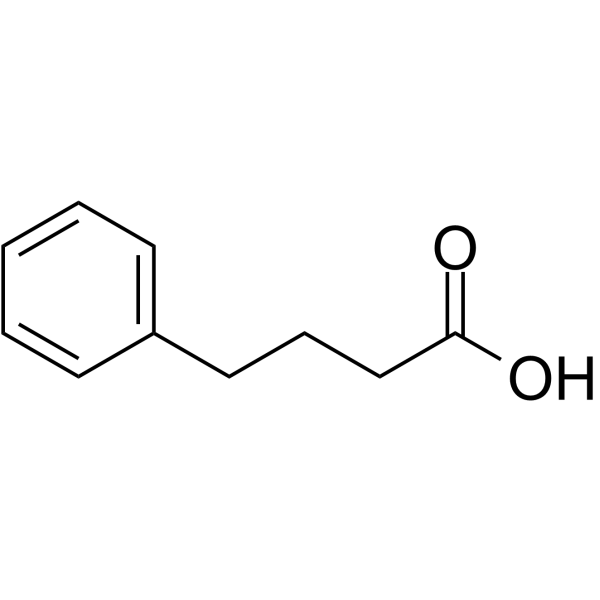上海金畔生物科技有限公司为生命科学和医药研发人员提供生物活性分子抑制剂、激动剂、特异性抑制剂、化合物库、重组蛋白,专注于信号通路和疾病研究领域。
4-Phenylbutyric acid (Synonyms: 4-苯基丁酸; 4-PBA; Benzenebutyric acid) 纯度: 99.98%
4-Phenylbutyric acid (4-PBA) 是一种组蛋白去乙酰化酶 (HDAC) 和内质网应激 (ER) 抑制剂,可用于癌症和感染等疾病的研究。

4-Phenylbutyric acid Chemical Structure
CAS No. : 1821-12-1
| 规格 | 价格 | 是否有货 | 数量 |
|---|---|---|---|
| Free Sample (0.1-0.5 mg) | Apply now | ||
| 500 mg | ¥400 | In-stock | |
| 5 g | ¥500 | In-stock | |
| 10 g | 询价 | ||
| 50 g | 询价 |
* Please select Quantity before adding items.
4-Phenylbutyric acid 相关产品
•相关化合物库:
- Drug Repurposing Compound Library Plus
- FDA-Approved Drug Library Plus
- Bioactive Compound Library Plus
| 生物活性 |
4-Phenylbutyric acid (4-PBA) is an inhibitor of HDAC and endoplasmic reticulum (ER) stress, used in cancer and infection research. |
||||||||||||||||
|---|---|---|---|---|---|---|---|---|---|---|---|---|---|---|---|---|---|
| IC50 & Target |
|
||||||||||||||||
| 体外研究 (In Vitro) |
4-Phenylbutyric acid (4-PBA) is an inhibitor of HDAC, inhibits the growth of NSCLC Cell Lines at 2 mM. Benzenebutyric acid in combination with ciglitizone results in enhanced growth arrest of cancer cells[1]. 4-Phenylbutyric acid (0-5 mM) inhibits ASFV infection in a dose-dependent manner. Benzenebutyric acid also inhibits the ASFV late protein synthesis and disrupts the virus-induced H3K9/K14 hypoacetylation status. Benzenebutyric acid and enrofloxacin act synergistically to abolish ASFV replication[2]. Addition of bafilomycin A1 results in accumulation of LC3II, whereas 4-Phenylbutyric acid substantially reduces this accumulation. LPS decreases the level of p62, whereas Benzenebutyric acid reverses this decrease upon LPS stimulation for 48 h. The percentage of cells with LPS-induced AVOs is increased at 48 h, whereas 4-Phenylbutyric acid significantly reduces this percentage. Specifically, the percentage of cells with AVOs decreases from 61.6% to 53.1% upon Benzenebutyric acid treatment, supporting that 4-Phenylbutyric acid inhibits LPS-induced autophagy. As a positive control for autophagy inhibition, bafilomycin A1 is used. The percentage of cells with LPS-induced AVOs is reduced by bafilomycin A1 treatment. The decreased OC area and fusion index observed after Benzenebutyric acid treatment are not observed with knockdown of ATG7. Inhibition of NF-κB using BAY 11-7082 and JSH23 reduce the LC3 II level upon LPS stimulation and completely abolish the inhibitory effect of Benzenebutyric acid on LPS-induced effects[3]. 上海金畔生物科技有限公司 has not independently confirmed the accuracy of these methods. They are for reference only. |
||||||||||||||||
| 体内研究 (In Vivo) |
LPS induces significant bone loss and decreases bone mineral density (BMD), bone volume (BV/TV), and trabecular thickness (Tb. Th) compared with PBS alone, whereas trabecular space (Tb. Sp.) is increased. 4-Phenylbutyric acid (4-PBA) attenuates LPS-induced bone loss. Treatment with 4-Phenylbutyric acid increases BMD, BV/TV, and Tb. Th. compared with LPS alone, in addition to decreasing the enlargement of Tb. Sp., but no change is observed when mice are treated with Benzenebutyric acid alone. OC.S/BS as assessed by TRAP staining is also significantly reduced when Benzenebutyric acid is administered to LPS-treated mice. However, OC.N/BS tends to decrease, although not with statistical significance, when mice are treated with Benzenebutyric acid and LPS. These results indicate that the effect of Benzenebutyric acid on OC from LPS-treated mice is to reduce its size rather than number. Consistent with these findings, a marker of bone resorption in vivo, serum CTX-1 which is elevated by LPS treatment is decreased when Benzenebutyric acid administered to LPS-injected mice. However, co-treatment with Benzenebutyric acid do not significantly affect the levels of serum ALP and osteocalcin, 2 markers of bone formation in vivo, compared with LPS alone. Benzenebutyric acid also reduces the LPS-induced rise in serum MCP-1, indicating that Benzenebutyric acid decreases systemic inflammation induced by LPS[3]. 上海金畔生物科技有限公司 has not independently confirmed the accuracy of these methods. They are for reference only. |
||||||||||||||||
| Clinical Trial |
|
||||||||||||||||
| 分子量 |
164.20 |
||||||||||||||||
| Formula |
C10H12O2 |
||||||||||||||||
| CAS 号 |
1821-12-1 |
||||||||||||||||
| 中文名称 |
4-苯基丁酸 |
||||||||||||||||
| 运输条件 |
Room temperature in continental US; may vary elsewhere. |
||||||||||||||||
| 储存方式 |
|
||||||||||||||||
| 溶解性数据 |
In Vitro:
DMSO : ≥ 100 mg/mL (609.01 mM) H2O : 2 mg/mL (12.18 mM; Need ultrasonic) * “≥” means soluble, but saturation unknown. 配制储备液
*
请根据产品在不同溶剂中的溶解度选择合适的溶剂配制储备液;一旦配成溶液,请分装保存,避免反复冻融造成的产品失效。 In Vivo:
请根据您的实验动物和给药方式选择适当的溶解方案。以下溶解方案都请先按照 In Vitro 方式配制澄清的储备液,再依次添加助溶剂: ——为保证实验结果的可靠性,澄清的储备液可以根据储存条件,适当保存;体内实验的工作液,建议您现用现配,当天使用; 以下溶剂前显示的百
|
||||||||||||||||
| 参考文献 |
|
| Cell Assay [1] |
Briefly, viable cells, as judged by trypan blue dye exclusion, are seeded at a density of 4×104 cells/mL in 60-mm dishes in RPMI 1640 with 10% fetal bovine serum and 0.35% agarose on a base layer of 0.7% agarose. DMSO, TSA, or PB is added to both bottom and top agarose layers. Assays are performed in triplicate on at least three separate occasions, and colonies are counted at 10-14 days[1]. 上海金畔生物科技有限公司 has not independently confirmed the accuracy of these methods. They are for reference only. |
|---|---|
| Animal Administration [3] |
Mice[3] 上海金畔生物科技有限公司 has not independently confirmed the accuracy of these methods. They are for reference only. |
| 参考文献 |
|
所有产品仅用作科学研究或药证申报,我们不为任何个人用途提供产品和服务
